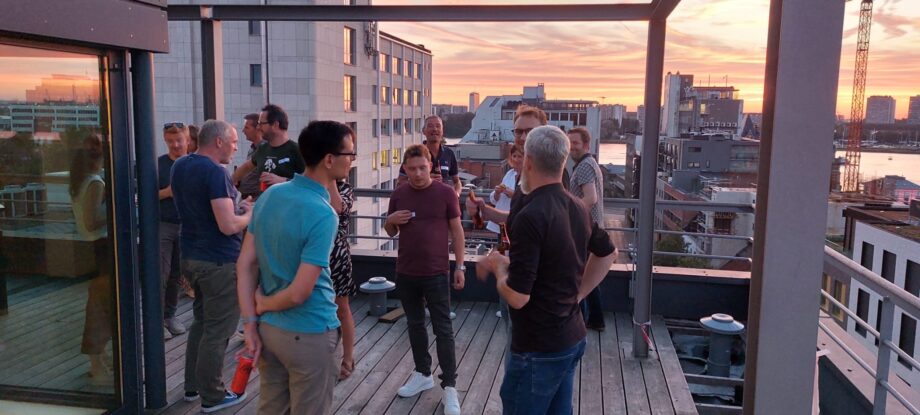On September 4th, our Agile Kitchen session focused on long-term agile growth within a team. iLeaners Frederik Vannieuwenhuyse and Philippe Vandessel introduced their ‘Team Growth Canvas’ in yet another interactive session. This canvas is a tool they developed, for every team that wants to improve their functioning while also considering the stakeholders’ and product’s needs. The Team Growth Canvas counts 9 steps, covered during the Agile Kitchen session. For those who didn’t make it, or just want a recap: read on!
Setting the Stage
Frederik and Philippe began by explaining the fundamentals of Scrum, a framework designed for incremental product delivery. Scrum defines both product goals and intermediate sprint goals aligned with the product vision. But what about team improvement? How do you align all that with evolving as a team?
The canvas they created, forms an answer to the question: “How can we provide a team with the proper means to grow in the longer term, next to focusing on product and business goals.”

The 9 steps of the Team Growth Canvas
1. Stakeholder Identification
The first step involves identifying the stakeholders who would benefit the most from the team’s improvement efforts. While some participants found it challenging to prioritize stakeholders before defining goals, this shift in perspective can be enlightening. Instead of starting with the team’s goals, consider what the stakeholders deem important for the team’s success.
2. Existing Pains
The second step delves into understanding the pains experienced by the team. This part of the canvas needs to be more defined in relation to stakeholders, as “pains” and frustrations within a team can be very diverse. To avoid an energy-draining meeting, you need to connect the ‘team pains’ to stakeholders in this step. By linking pains to what stakeholders want to see improved, teams can focus on relevant issues. For example, if consistently failing to deliver planned work frustrates stakeholders, this pain point becomes evident and actionable.
3. Current Strengths
Step three prompts teams to identify their current strengths, guided by a range of possible exercises. However, this step also needs further refinement, specifically in terms of aligning strengths with what stakeholders value. Strengths should serve the purpose of satisfying stakeholders’ expectations. Another valuable lesson to learn when further developing the Team Growth Canvas!
4. Team Needs
Step four aims to determine what success truly means for the team. Some participants questioned the necessity of this step, considering that stakeholders and pain points already provide valuable insights. This feedback suggests a potential simplification of the model.
5. Long-Term Team Goals
Step five revolves around defining the team’s long-term goals, and motivating the team to envision where they want to be in the coming months. It’s crucial to consider these goals in relation to both the team’s and stakeholders’ expectations, otherwise you’re going nowhere. Ensuring alignment between these two perspectives is paramount. This step is also something to further develop in more depth. Maybe another blank paper to really zoom in on the most important goals.
6. Key Metrics
Now we arrived at the more self-explanatory steps of the canvas. In order to track team goals, they must identify the metrics. How will you measure your improvement? What’s the definition of success? How will you follow up if you’re going in the right direction?
7. Cadence
Another practical and logical step: cadence or ‘rhythm’. The team needs to determine the frequency of meetings and planning sessions, required to monitor progress toward the team goals.
8. Possible Improvement Experiments
This step encourages teams to brainstorm about experiments and strategies to achieve their goals. Great things never come from comfort zones – right?
9. Next Growth Opportunity
Step 8 and 9 need to alternate to get to the best possible outcome for a team goal. Because in step 9 you choose an experiment to test, revise and then adjust by looking back to other possibilities in step 8. With what experiment or exercise will you start first?
Extra: Non-negotiables
While not explicitly part of the canvas, defining non-negotiable values and rules within the team is essential. Their placement within the canvas model is a topic for further discussion, ensuring it remains a valuable part rather than becoming an appendix. To be examined further!
We don’t hold the absolute truth
The canvas model’s foundation lies in the assumption that teams actively pursuing and achieving improvement goals, even if they set the bar low, build a basis for long-term maturity. It initiates a journey toward continuous growth and maturity as a team. This assumption, while based on experience, remains open to challenge, as it is merely a hypothesis and not the absolute truth. We focus on the process and believe results will come. But others might say you need to focus on the results and adjust your process to it. Both are up for discussion.
Lessons learned
The Team Growth canvas is a helpful tool to develop team goals and improvement, in a valuable way for both the team and stakeholders. We learned there are still some adjustments to make, so now Frederik and Philippe can get going with optimizing the canvas in more depth. Once they apply it in various contexts and several times, it will be easier to share and show their learnings in workshops like our Agile Kitchen, making it more hands-on and practical for participants.
Conclusion
The canvas model introduced by Frederik and Philippe offers a structured approach to defining and pursuing team improvement goals. By bridging the gap between product goals and team improvement objectives, it enables teams to align their efforts with stakeholder expectations and business purposes. The success of this model will depend on its application and refinement in different scenarios, and it represents a promising step toward achieving long-term agile growth. We’re looking forward to it!


